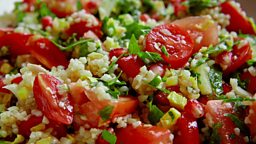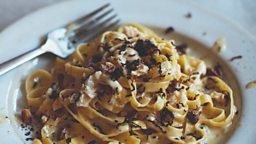Borsch
Food writer Alissa Timoshkina transforms perceptions of the food of the former Soviet Union and in particular her home Siberia – the crossroads of Eastern European and Central Asian cuisine. Salt & Time contains recipes from the pre-revolutionary era and the Soviet days that are treated with a modern interpretation.

Salt & Time: Recipes from a Russian kitchen by Alissa Timoshkina is published by Mitchell Beazley
Photography: Lizzie Mayson
Borsch to Eastern Europe and Russia is like hummus to the Middle East. We all eat it, we all love it, yet we simply can’t imagine that any other country owns the rights to it. It has its origin in a hogweed soup commonly consumed by the Slavs from the 15th–16th century in territories occupied today by Poland, Ukraine and Russia. There are so many variations of the soup, not only in each country but in different regions within those countries, that borsch often becomes synonymous with Eastern European soup. As much as I love a good traditional borsch, and to me this means a passionately red beetroot soup, cooked with a soffritto base as my Jewish–Ukrainian greatgrandma would do, I sometimes struggle eating a plateful of chunky discoloured vegetables that have given all their best to the broth. So here I am taking a bit (okay, a lot) of creative licence, offering my own take on the iconic dish, which consists of a rich red broth, raw sauerkraut, roasted vegetables and baked red kidney beans. Lovers of traditional borsch recipes look away – this one is pretty iconoclastic!
If you can make the broth 24 hours in advance, you will be rewarded with an even better tasting soup, but a few hours of resting will also do the trick.
SERVES 4
—
unrefined sunflower oil,
for frying and roasting
1 large onion, finely diced
1 carrot, peeled and grated
6 raw red beetroots
2 red peppers
2 tablespoons tomato purée
2 litres cold water
2 bay leaves
1 tablespoon black
peppercorns
1 tablespoon coriander seeds
1 tablespoon fennel seeds
4 garlic cloves, peeled
bunch of dill
small bunch of flat leaf parsley
2 garlic cloves, grated
500g Red Sauerkraut
with Garlic & Chilli
(see page 159)
2 tablespoons pomegranate
molasses
1 red onion
1 tablespoon brown sugar
400g can red kidney beans
2 teaspoons smoked paprika
4 tablespoons soured cream
salt
Heat up a tablespoon of sunflower oil in a large pan and fry the onion and carrot for about 8 minutes until golden. Meanwhile, peel and grate 2 of the beetroots and core, deseed and thinly slice 1 red pepper. Add the vegetables to the pan together with the tomato purée and a splash of water. Season with salt to taste and fry for a further 5–8 minutes.
Top with the measured cold water, add the bay leaves along with the peppercorns and all the seeds, whole garlic cloves and half the bunches of dill and parsley. Season with a tablespoon of salt and bring to the boil. Reduce the heat, add the grated garlic and half the sauerkraut with its brine and simmer, covered, over a low heat for 40 minutes–1 hour.
Turn off the heat and let the borsch rest for another hour, while you prepare the rest of the elements.
So far, so good, but here is where the recipe starts to deviate from the norm quite a lot: to prepare the vegetables that will grace the plate and also add extra flavour and texture to the soup, you will need to do a bit of roasting.
Start by preheating the oven to 160°C fan/Gas Mark 4. Peel the remaining 4 beetroots, cut into wedges and dress with oil, salt and the pomegranate molasses. Peel the red onion, cut into wedges and season with salt and the brown sugar to bring out their sweetness and promote caramelization. Place on a roasting tray with the beetroot and roast together for 30 minutes. Drain the kidney beans, then dress them with salt, oil and the smoked paprika. Core and deseed the remaining red pepper, then cut into thin strips and dress with salt and oil. Roast the beans and pepper together, as they will need only 10–15 minutes.
When ready to serve, strain the broth through a sieve or a muslin cloth, discarding the solids. All we need is that rich broth! Reheat again if necessary. Next, create layers of texture and flavour in each bowl by adding a heaped tablespoon of the remaining sauerkraut to each, as well as a handful of roasted beetroot, onion, kidney beans and red pepper. Top each bowl with the hot broth and add a dollop of soured cream and a generous sprinkle of the remaining dill and parsley, chopped. The intensity of the flavours and textures of this dish is beyond words, while the look of the bowl will seduce the eye without a doubt.
More Food on the 大象传媒
-
![]()
Browse our selection of recipes from top chefs, cooks and food writers who have joined us on Woman's Hour...
-
![]()
Download this interview, or subscribe to the Cook the Perfect...downloads
-
![]()
Browse over 13,000 recipes on the 大象传媒 Food website














































